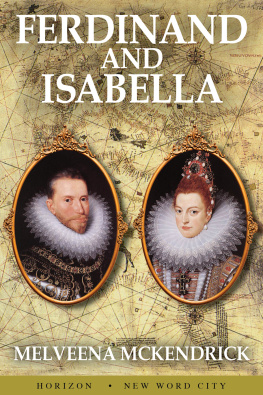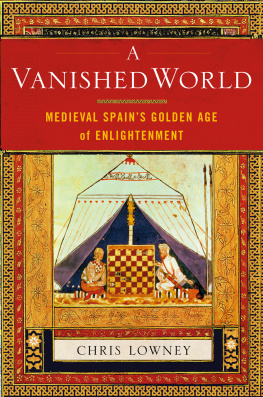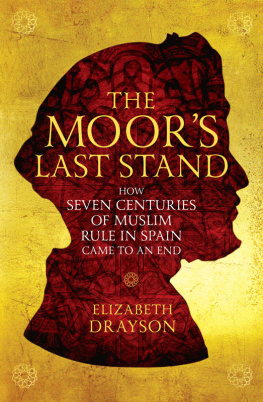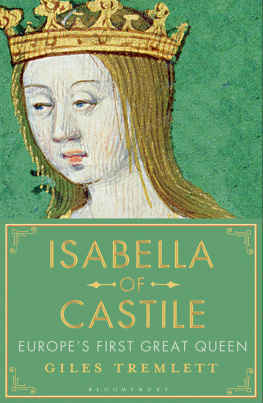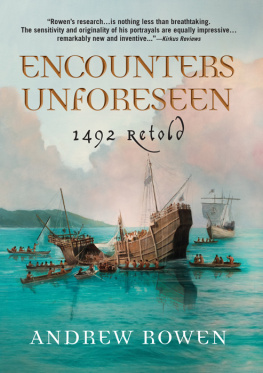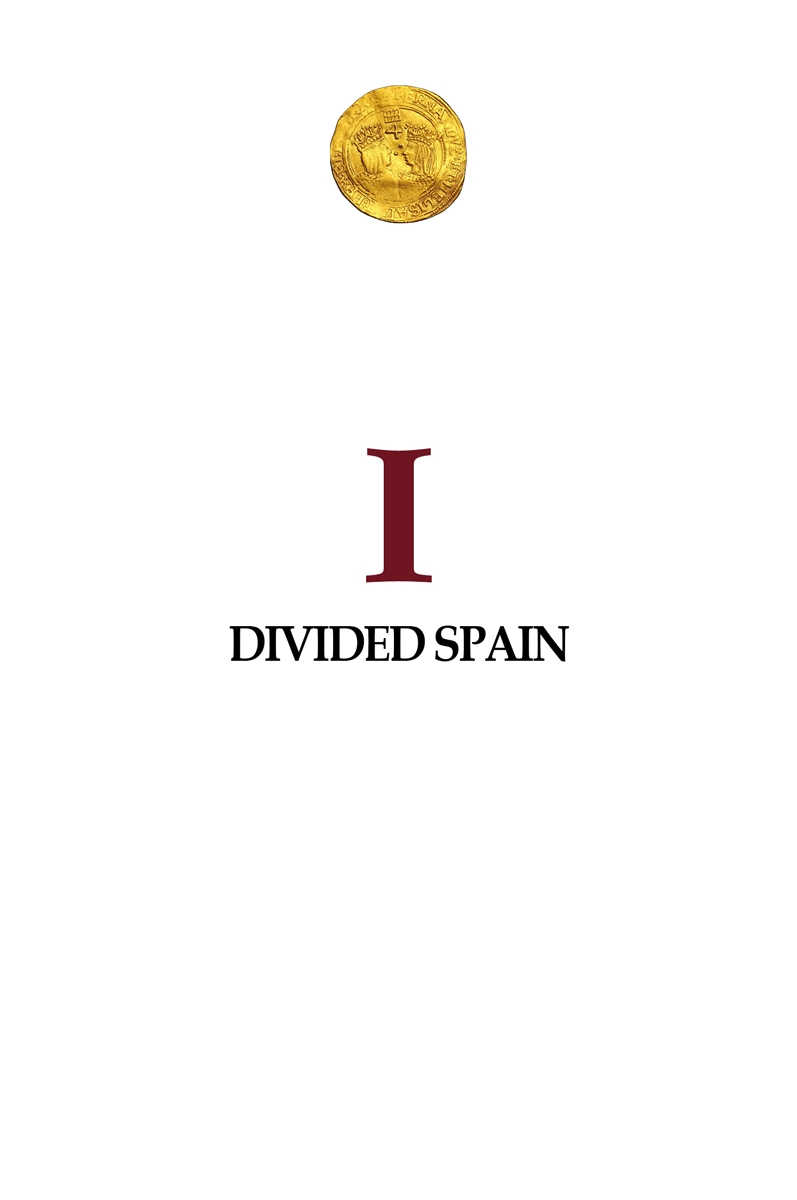One night in early October 1469, a small party of merchants set out across the mountains above Saragossa in the Spanish kingdom of Aragn. Their destination was the town of Valladolid in the neighboring kingdom of Castile and Len. Although their mules were loaded with boxes and bales, these men were no ordinary merchants. The shabbily-dressed boy of seventeen who tended the mules was, in fact, their young master, Ferdinand, King of Sicily and heir to the crown of Aragn. In Valladolid, he was to meet and marry the eighteen-year-old Infanta Isabella, heiress of Castile.
Ferdinand traveled in disguise and at night for two reasons: first, because Isabellas half-brother, King Henry IV of Castile, and most of his nobles were eager to prevent the wedding; and second, because Ferdinands father, old King John of Aragn, could afford neither the men nor the money his son would have needed to enter hostile Castile in a manner becoming his rank.
The journey was a long and dangerous one. The merchant caravan, winding its way through the wild sierra country that divided Aragn and Old Castile, had to keep a constant lookout for the robber bands that infested the mountains. Once safely through, the travelers followed the curving river Duero across the empty, rock-strewn plains of the Castilian tableland. Whenever they stopped at some lonely inn, Ferdinand, to avoid suspicious glances from the innkeeper and fellow guests, waited on the other members of the caravan and fed and watered their mules.
At Burgo de Osma, a walled town perched high above the Duero, he was suddenly forced to reveal his identity. Some of Isabellas partisans challenged him from the battlements. Whatever reply he invented on the spur of the moment was obviously not satisfactory. One of the sentries hurled a large stone that narrowly missed killing the future King of Spain. When Ferdinand revealed that he was their princesss bridegroom, however, the townsfolk quickly made up for their hostility, and the mayor himself escorted the prince on the next stage of his journey, to Dueas in Len. Here Ferdinand was greeted by a band of nobles who were loyal to Isabella, and he could abandon his disguise at last.
Six days later, on October 15, he rode into Valladolid to meet his bride for the first time. Isabella was waiting for him in the private house where she had been staying. With her were the Archbishop of Toledo, a strong supporter of the proposed match, and her lifelong friend, a girl her own age named Beatriz de Bobadilla. Isabella had dressed simply for the occasion, and her only ornament was a magnificent gold and ruby necklace that Ferdinand had sent her as a present. The two young people talked together for two hours, and then Ferdinand returned to Dueas, eighteen miles away.
By arranging to marry Ferdinand, Isabella was deliberately defying her half-brother the king, who had other plans for her marriage, plans that dismayed her. She had risked a great deal by coming to Valladolid and asking Ferdinand to meet her there. But she was cautious by nature and had already insisted on writing to the king, asking for his approval. The marriage, she now said, could not go ahead until she received his answer. However, the Archbishop, who was alarmed that an unfavorable reply might upset everything, managed to persuade her that the wedding should not be postponed. Isabella then raised another objection. Since she and Ferdinand were second cousins, they could not marry without a dispensation from the Pope. A letter requesting this would have to be sent to Rome.
By now the suspense was unbearable. Fortunately, King John, Ferdinands wily father, had foreseen such an obstacle, and he and the Archbishop between them had forged a papal bull of dispensation that authorized Ferdinand to marry any female cousin if he so wished. This was now shown to the unsuspecting Isabella, and the Archbishop proclaimed joyfully that the marriage could proceed.
On October 19, the couple were quietly married by the Archbishop of Toledo in the same house where Isabella had been staying. There was none of the pomp, pageantry, and splendor usually associated with royal weddings. Only after they were safely married could the cloak of secrecy be thrown off, and even then, they had to borrow the money to pay for the week-long celebrations that followed.
This furtively-contracted marriage was to prove one of the most important events in Spanish history. It meant that when Ferdinand and Isabella in turn acceded to their separate thrones, the kingdoms of Aragn and Castile that formed the greater part of what is now known as Spain - would be united. Although each kingdom was to remain separate, the same heir would inherit them both. This would inevitably, if not immediately, mean the integration of the two. Upon unity depend power and strength, and it was as a united country that Spain was to become one of the foremost powers of Europe in the sixteenth and seventeenth centuries.
The concept of Spain as a nation emerged during the reign of Ferdinand and Isabella. But the task of molding a collection of sovereign states into a more-or-less united whole was by no means an easy one. It was to take all of Isabellas resolute and selfless devotion and all of Ferdinands military ability and diplomatic guile.
The land to which they were born had a long and turbulent past, so turbulent that it is impossible to appreciate the extent of their achievements without first realizing exactly how much they had to contend with.
From earliest times, when the land was occupied by the primitive Iberians who gave their name to the peninsula, Spain suffered a series of invasions, reconquests, and civil wars. Phoenicians, Celts, Greeks, Carthaginians, and Romans occupied the country in turn. In the fifth century A.D., as the Roman Empire crumbled under barbarian attacks, successive waves of Suevians, Alans, Vandals, and Visigoths poured into Spain, adding to the existing mixture of races.
In 711 came the most fateful invasion of all, when the Arabs crossed the Strait of Gibraltar and established the religion and culture of Islam throughout Spain. The Visigothic King Rodrigo disappeared in battle, and his few remaining followers fled to the mountains in the far north. Within eight years, the Arabs dominated the entire peninsula - a situation that was to continue for another 500 years. When Isabella married Ferdinand in 1469, the kingdom of Granada was still under Arab control, and the Spain they inherited had been shaped by the centuries of combined co-existence and warfare with the Moors, as the Arabs in Spain are usually called.
It was from the remote and rugged land of Asturias in the north of Spain that the Christians launched the movement to win back their country: the Reconquest. A Visigothic chieftain named Pelayo (Pelagius) was elected as Rodrigos heir, and in 718, Pelayo led the Christians to their first victory over the Muslims in the deep mountain gorge at Covadonga. As a result, they managed to secure the tiny kingdom of Asturias for themselves and gradually added to it by more conquests.
By the beginning of the tenth century, Asturias had grown big enough to be divided by one of its kings into smaller kingdoms, each ruled by one of his sons: Asturias proper; Galicia and the area that was to become northern Portugal; and the territory of Len. The eastern region of Len, which gradually assumed a dominant role in the war against the Moors, was itself to become a separate province known as Castile because of its numerous frontier castles. Still farther to the east, other small kingdoms had sprung up as more territory was regained from the Muslims: first, Catalonia, retaken by Charlemagne; then, Navarre, established by Basque warriors just south of the Pyrenees; finally, Aragn, the area between the two.

